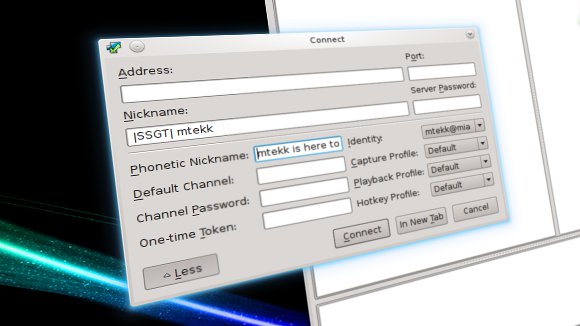From 3:15AM CDT to 6:05PM CDT, on Friday, September 30th, 2011 Weblogs.us experienced an outage on one of its servers. It all stemmed from a simple support request, and a very hacky fix implemented back in July (while I was on vacation). This is part one of the story behind the outage, and you can blame me for it.
Tag Archives: Linux
Make Teamspeak 3 Use Your QT libs
After upgrading some core files this past week on my laptop, I noticed that Teamspeak 3 no longer would open. I have a desktop icon that calls the script that starts Teamspeak. When I opened up a terminal and tried to run the script, I recieved this error:
ts3client_linux_amd64: error while loading shared libraries: libpng12.so.0: cannot open shared object file: No such file or directory
Well, I have libpng 1.4.3 on my laptop, and I’d prefer to not have multiple versions installed. Luckily, the cause of this issue is the QT4 library files that ship with Teamspeak 3. If you have KDE4, like I do, then all you have to do is move these QT files out of the Teamspeak 3 install directory. A quick way to do this is to use the following once you are in the directory where Teamspeak 3’s files are located:
mkdir backup
mv libQt* ./backup/
Now Teamspeak 3 will use your already installed system QT4 library files, and Teamspeak 3 should now work with modern versions of libpng.
-John Havlik
[end of transmission, stay tuned]
Making Firefox and Thunderbird Less Ugly in KDE4
Mozilla uses the GTK for its applications’ GUIs. As every KDE user knows, KDE uses QT (KDE4 uses QT4.x), and GTK applications look ugly in KDE. There are ways of getting GTK applications to look not as bad in KDE (qtCurve). However, these typically are a custom qt theme, which is not what I want (I’d rather skin the few misbehaving applications).
Luckily, for Firefox there is a very good theme called Oxygen KDE. You want version 2.0.1 or newer. It works very well, and applies to any Linux distribution. Thunderbird has something similar, named Oxybird. The original works with Thunderbird 2.x, you’ll want Oxybird 2 for Thunderbird 3.1.x. I have not tried Oxybird with Thunderbird 2.x, so I can not speak for it in that environment, but in Thunderbird 3.1.x it is not as polished and will not give you the same KDE look and feel that Oxygen KDE does for Firefox.
Continue readingBattlefield Heroes Server Admin in Linux
Yes, you can run BFHCC.exe in Linux under wine. You just need to use some of the Microsoft libraries (OLE32 is just one of many that are needed). If invoked from the same directory as BFHCC.exe resides, it will load your settings just fine. However, it won’t let you warn, kick, or ban players (the pop up menu when right clicking on a player name does not work). Additionally, it runs kinda slow (I am running a 64bit kernel with a 32bit Wine install for compatibility reasons).
The other, somewhat more powerful, Battlefield Heroes server manager, Ness Manager, works perfectly in Linux. Best of all it doesn’t need Wine to run. This is thanks to it being completely written in Java. Naturally, you need a Java run time environment (JRE) installed for this to work. To install it you may need Wine (it’s a .exe installer), but once the files have been installed, you’ll notice they are all .jar files. Copy these to a place you can access easily. To start Ness Manager all you need to do is type java -jar BFHNessManager.jar while in the directory where you have Ness Manager installed in. Ness Manager works exactly as it does in Windows, which is great, and runs fast compared to BFHCC.
-John Havlik
[end of transmission, stay tuned]
Set Phonetic Nickname in Teamspeak 3 on Linux

Most gaming clans use VoIP software to communicate in game, one of the most popular applications for this is Teamspeak. Starting in Teamspeak 3.0, a text-to-speech engine is included to provide notifications of players entering and leaving channels (among other things). By default, Teamspeak will try to pronounce your nickname, not always a good thing when the nickname contains your rank (e.g. “|sgt| mtekk”, we want everyone to hear just “mtekk”) as the engine pronounces “|” as “vertical line”. In Windows and OS X you can use “Set Phonetic Nickname” under the “Self” menu. In Linux, the prompt will open, but the text box is disabled. This is due to a text-to-speech engine not shipping with the Linux version of Teamspeak3.
So how do we set the phonetic nickname in Linux? Well, it’s really simple. Go to “Connections > Connect”. In that prompt click the “more” button. You should now see a field that is labeled “Phonetic Nickname”.
Alternately, you can dive into the Teamspeak configuration files (like I did). Under your home directory there should be a directory named “.ts3client”, in a terminal you can see it using ls -a ~/. Within .ts3client there should be a file named “ts3clientui_qt.conf” open this up with your favorite text editor (e.g. nano: nano ~/.ts3client/ts3clientui_qt.conf). Scroll down to the bottom of this file, there should be a section named “[Connecting]” the last field should be “LastUsedPhoneticNickname=” just append to this setting your phonetic nickname (e.g. “LastUsedPhoneticNickname=mtekk”).
-John Havlik
[end of transmission, stay tuned]
